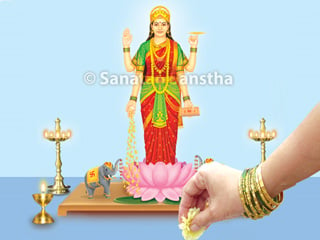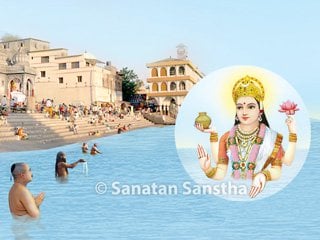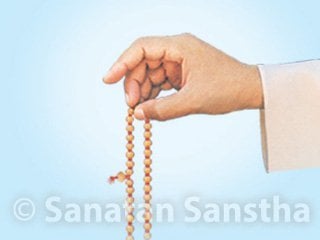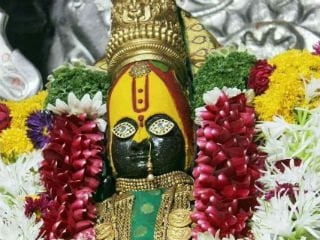Contents

Lakshmi means a symbol. It is from this that the word ‘Lakshmi‘ has been derived. A substitute word for Lakshmi is ‘Shri’ that means adornment, lustre. Since the word ‘Shri’ is derived from the symbol swastik, it seems quite likely that the symbol representing Lakshmi must be the swastik. We come across both the words – Shri and Lakshmi in the Rigveda. A supplement of Rigveda is famously known as the Shrisukta.’ ‘Shri’ is the Deity of fortune. Vedic literature has described the expansive form of Shri or Lakshmi as the Deity who ‘enriches’ by bestowing prosperity, wealth, health and longevity, progeny and continuation of the family tree, abundant food grain, servants etc. ‘A deeper meaning has been attached to the blossoming of the lotus with the touch of the rising sun. The sun is the representative highest being of the ‘dyu’ region (Dyulok is a part of Swargalok [Heaven]) while the earth is his beloved. The implied meaning of this is that the union of heaven and the earth gives birth to the universe. In this way, Sages have associated the earth, that is, Shri, who has the capacity to reproduce, with the lotus.
1. Unique characteristics
A. Fickleness : With a view to express Lakshmi’s shortcomings, Parvati called Her ‘Lola’, which means one who is fickle. Fickleness and unsteadiness are indeed Lakshmi’s weakness. Obviously, here Lakshmi refers to wealth and riches, opulence and splendour. Wealth in a family is not sustained over the generations. It finds new destinations. The reasons for this are vices, opulence, haughtiness, extravagance and stupidity of men in the family. Consequently, if Lakshmi is compelled to leave the house, is it Her fault ? Lakshmi is blamed for the defects of man.
B. Behaves as per the wish of Her master : She behaves in accordance with the wishes of Shrivishnu.
C. Strength and arrogance are the two sons of Lakshmi. They are called so because frequently it is seen that the one who is blessed by Lakshmi becomes powerful and arrogant as well.
2. Mission of Shri Lakshmi
Whenever Shrivishnu incarnates, Shri Lakshmi follows suit as His wife; for example, as Sita along with the Incarnation of Ram and Rukmini along with the Incarnation of Krushna. In the Valmiki Ramayan, Sita is Ram’s wife. She is steadfastly devoted to Her husband. Her form is extremely gentle and sattvik. In the Adhyatma Ramayan too She is described similarly. However, the AdbhutRamayann portrays Her as a fearsome form of Shakti.
Kirti (Fame), mati (Intellect), dyuti (Light), pushti (Grace of God), samruddhi (Prosperity), tushti (Happiness), shruti (Spiritual knowledge), smruti (Memory), bal (Strength), medha (Spiritual intellect), shraddha (Faith), arogya (Health), jai (Victory) etc. are all the Shaktis which have originated from the fractions of Deities associated with them. All these Shaktis are essential for a prosperous life and they serve Shri Lakshmidevi like maids.
3. Some forms
As Lakshmi proved to be the bestower of opulence, Her following forms were conceived – A. Dhanlakshmi (Lakshmi bestowing wealth), B. Dhanyalakshmi (Lakshmi bestowing food grain), C. Dhairyalakshmi (Lakshmi bestowing courage), D. Shouryalakshmi (Lakshmi bestowing valour), E. Vidyalakshmi (Lakshmi bestowing knowledge), F. Kirtilakshmi (Lakshmi bestowing fame), G. Vijaylakshmi (Lakshmi bestowing victory) and H. Rajyalakshmi (Lakshmi bestowing a kingdom). These eight are worshipped in some form or the other.
I. Gajalakshmi : In the concept here, Lakshmi is the earth and the elephants which are shown sprinkling water are representative of the Deities. Sprinkling water is symbolic of high fertility. In Maharashtra, Devi Gajalakshmi is worshipped as a village Deity.She is named Bhaveshwari, Bhavakai etc. In several places, She is worshipped for safe childbirth, because She is the Deity who grants success. The Idol of Gajalakshmi expresses the secret of the entire Creation.
J. Yogamaya (Yoganidra) : ‘The Yoganidra or Yogamaya form of Shri Durga is associated with Shrikrushna, that is, Shrivishnu. Before taking birth as Krushna in Kansa’s prison, Shrivishnu directed Durga to be born to Yashoda and She complied. Later Vasudev took the newborn Krushna to Gokul and placed Him on Yashoda’s bed and returned with the infant Yogamaya to Kansa’s prison in Mathura. Hearing Her cry, Kansa rushed there and decided to kill Her by striking Her upon a rock. However, Yogamaya escaped from his clutches, vanished into space and merged into Shrivishnu. The Bhagwat, Harivansh and Vishnupurana state that later Indra created an abode on the Vindhya Mountain for Yogamaya.
4. Idol of Shri Lakshmi
According to the Vishnu-dharmottarpurana, when Shri Lakshmi is to be portrayed beside Shrivishnu, She should have two arms and when She is to be depicted alone, She should have four arms. In the latter form, an elephant, a lotus, gold (in the form of ornaments or coins) and a bel (Aegle marmelos or wood apple) tree and bel fruit are associated with Her. Mostly, Lakshmi is depicted seated at the feet of Shrivishnu.
5. Worship
The shloka (Verse in Sanskrut) to be recited in the morning upon waking up:
Karagre vasate Lakshmih karmadhye Saraswati
Karmule tu Govindah prabhate karadarshanam
Meaning : The finger tips, the centre and the root of the palms are the abodes of Lakshmi, Saraswati and Govind respectively. Hence, we should look at our hands upon waking up in the morning.

 Ganga – Shakti in the form of rivers
Ganga – Shakti in the form of rivers Why do we chant Name of Kuladevi instead of Kuladev?
Why do we chant Name of Kuladevi instead of Kuladev? What are the different types of Shaktis?
What are the different types of Shaktis? Ritualistic worship of Devis
Ritualistic worship of Devis Why is Adimaya referred to as kumari ?
Why is Adimaya referred to as kumari ?